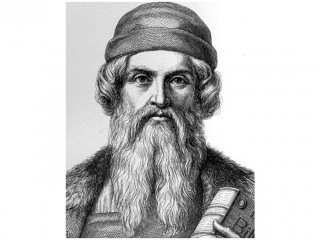
Johannes Gutenberg biography
Date of birth : -
Date of death : 1468-02-03
Birthplace : Mainz, Germany
Nationality : German
Category : Science and Technology
Last modified : 2011-10-03
Credited as : Inventor, Writer,
37 votes so far
Gutenberg was the first European to use movable type printing, in around 1439, and the global inventor of the printing press. Among his many contributions to printing are: the invention of a process for mass-producing movable type; the use of oil-based ink; and the use of a wooden printing press similar to the agricultural screw presses of the period. His truly epochal invention was the combination of these elements into a practical system which allowed the mass production of printed books and was economically viable for printers and readers alike. Gutenberg's method for making type is traditionally considered to have included a type metal alloy and a hand mould for casting type.
The use of movable type was a marked improvement on the handwritten manuscript, which was the existing method of book production in Europe, and upon woodblock printing, and revolutionized European book-making. Gutenberg's printing technology spread rapidly throughout Europe and later the world.
His major work, the Gutenberg Bible (also known as the 42-line Bible), has been acclaimed for its high aesthetic and technical quality.
The capital of printing in Europe shifted to Venice, where visionary printers like Aldus Manutius ensured widespread availability of the major Greek and Latin texts. The claims of an Italian origin for movable type have also focused on this rapid rise of Italy in movable-type printing, but this may perhaps be explained by the prior eminence of Italy in the paper and printing trade, and also the dispersal of Gutenberg's compositors and typefounders (like Nicolas Jenson) after the sack of Mainz in 1462.
Printing was also a factor in the Reformation: Martin Luther found that the 95 Theses, which he posted on the door of his church, were printed and circulated widely; subsequently he also issued broadsheets outlining his anti-indulgences position (ironically, indulgences were one of the first items Gutenberg had printed). The broadsheet evolved into newspapers and defined the mass media we know today.
In the decades after Gutenberg, many conservative patrons looked down on cheap printed books; books produced by hand were considered more desirable.
There are many statues of Gutenberg in Germany, including the famous one by Bertel Thorvaldsen (1837) in Mainz, home to the Gutenberg Museum and the eponymous Johannes Gutenberg University of Mainz. The Gutenberg Galaxy and Project Gutenberg also commemorate Gutenberg's name. Matthew Skelton's book Endymion Spring explores a controversial theory about Johann Gutenberg and his partner Fust.
















